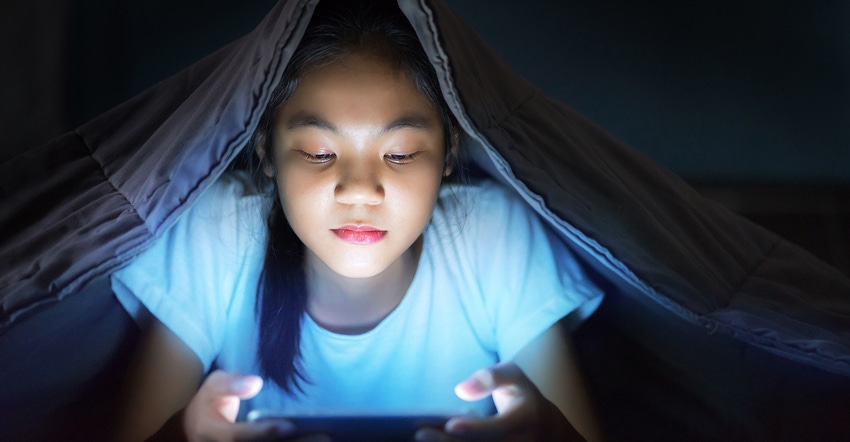The carotenoids lutein and zeaxanthin can help younger consumers address eye health concerns amid their high-screen lifestyles.

Eye health products are a thriving category in the dietary supplement industry—especially among Baby Boomers and even among Gen Xers who have concerns about the declining quality of their vision. But it turns out Gen Z is a largely untapped market for eye health products—and it all has to do with blue light.
Blue light
Blue light is a wavelength of light that passes through the lens of our eyes and can make its way back to the macular area of the retina, where has great potential to damage retinal tissue. Furthermore, blue light overexposure can cause computer vision syndrome, symptoms of which include headache, eye fatigue and other indications of eye strain associated with blue light overexposure.1
Unfortunately, blue light is ubiquitous. Sources include sunlight, digital devices (computers, tablets, smart phones, televisions, etc.) and artificial light.2,3,4,5,6,7 Children may be at higher risk for blue light retinal damage than adults. The juvenile lens absorbs less short-wavelength light than the adult lens, allowing more blue light to reach a child’s retina.8,9 This is problematic since the long-term consequences of blue light exposure in children are not well understood, although we know quite about the short-term consequences.
Research published by the Vision Council indicated that, after being exposed to two or more hours of screen time a day, children experience headaches (8.8%), neck/shoulder pain (5%), eye strain, dry or irritated eyes (9.1%), reduced attention span (15.2%), poor behavior (13.3%) and irritability (13.5%).10 Electronic devices are able to stimulate blue-light-sensitive ganglion cell photoreceptors that regulate circadian rhythms,11 exposure before bedtime can delay sleep onset, degrade sleep quality and impair alertness the following day.12 Limitation of personal electronic device use before bedtime is recommended to be the most effective method for reducing light-induced sleep disruption in children.
Kids and young adults born in the 1990s or later—and Generation Z kids were born between 1995 and 2015—are the first generation to have been exposed to high levels of blue light at an early age, so their collective lifetime blue light exposure is much greater than that of earlier generations. Also, about 50% of the population tested experienced symptoms of digital eye strain with six or more hours daily of digital device use.13 Consequently, Gen Z needs protection against blue light more so than any preceding generation.
Lutein and zeaxanthin isomers
It turns out lutein and zeaxanthin isomers (rr- and rs-(meso)-zeaxanthin) appears to be just the type of protection that is needed. These carotenoids (related to beta-carotene and lycopene) found in some foods and deposited in the part of the retina where they play a critical role in protecting against blue light14—and supplementation can help.
A study conducted at the University of Georgia found that supplementing with lutein and zeaxanthin isomers (as Lutemax® 2020 from OmniActive Health Technologies) reduced headaches, eye fatigue and eye strain from digital devices.15 Another double-blind, placebo controlled, 12-month trial examined the effects of lutein and zeaxanthin isomers (as Lutemax® 2020) versus placebo.16,17 Two levels of daily lutein supplementation were used: 10 mg of lutein (2 mg of zeaxanthin) and 20 mg of lutein (4 mg of zeaxanthin). In addition, lutein/zeaxanthin improved brain-derived neurotropic factor (BDNF), which is active in areas of the brain involved in learning, memory and higher cognitive processes.18
Quality of sleep
Lutein and zeaxanthin also improved sleep quality. The body produces melatonin at night when it gets dark.19 However, with the continued use of TV and digital devices, melatonin production decreases.20 But a three-month, double-blind, placebo-controlled trial with 45 healthy individuals (the first of a two-part study) presented at the 2016 annual meeting of the Association for Research in Vision and Ophthalmology found that Lutemax® 2020 significantly improved overall sleep quality (P=0.0063), with no changes in the placebo group. The second six-month, double-blind, placebo-controlled trial in 34 healthy individuals found similar results.
Delivery forms
Although lutein/zeaxanthin isomers are available as capsule or tablet supplements for adults, alternative deliver forms such as gummies may be more popular with Gen Z. Furthermore, younger children can’t easily swallow capsules or tablets in many cases.
Gene Bruno is professor of nutraceutical science for Huntington University of Health Sciences and serves a senior director of product innovation for Twinlab Consolidation Corp. Bruno holds bachelor’s and master’s degrees in nutrition, as well as a graduate diploma and master’s degree in herbal medicine. As a 40-year veteran of the dietary supplement industry and award-winning formulator, he has developed natural products for dozens of dietary supplement companies; educated and trained natural product retailers and health care professionals; and written articles on nutrition, herbal medicine, nutraceuticals and integrative health issues for trade, consumer and peer-reviewed publications, as well as authoring books and textbook chapters.
References
Randolph S. “Computer Vision Syndrome.” Workplace Health Saf. 2017 Jul;65(7):328. DOI: 10.1177/2165079917712727.
Nakashima Y et al. “Blue light-induced oxidative stress in live skin.” Free Radic Biol Med. 2017 Mar 15; PII: S0891-5849(17)30134-X.
Tosini G, Ferguson I, Tsubota K. “Effects of blue light on the circadian system and eye physiology.” Mol Vis. 2016 Jan 24;22:61-72.
The Vision Council. “Eyes Overexposed: The Digital Device Dilemma.” 2016 Digital Eye Strain Report. Thevisioncouncil.org.
The Vision Council. “Hindsight is 20/20/20: Protect your eyes from digital devices.” 2015 Digital Eye Strain Report. Thevisioncouncil.org.
Smick K et al. “Blue Light Hazard: New Knowledge, New Approaches to Maintaining Ocular Health.” Report of a Roundtable: March 16, 2013, New York City, NY, USA. Essilor of America.
Kuse Y et al. “Damage of photoreceptor-derived cells in culture induced by light emitting diode-derived blue light.” Sci Rep. 2014 Jun 9;4:5223.
Boettner E, Wolter J. “Transmission of the Ocular Media.” Investigative Ophthalmology 1962;1:776-83.
Behar-Cohen F et al. “Light-emitting diodes (LED) for domestic lighting: any risks for the eye?” Prog Retin Eye Res. 2011 Jul;30(4):239-57.
Berson D, Dunn FA, Takao M. “Phototransduction by retinal ganglion cells that set the circadian clock.” Science 2002;295:1070-3.
Berson D, Dunn F, Takao M. “Phototransduction by retinal ganglion cells that set the circadian clock.” Science 2002;295:1070-3.
Chang A et al. “Evening use of light-emitting eReaders negatively affects sleep, circadian timing, and next-morning alertness.” Proc Natl Acad Sci U S A 2015;112:1232-7.
Sheppard A, Wolffsohn J. “Digital eye strain: prevalence, measurement and amelioration.” BMJ Open Opthalmol. 2018; 3(1):e000146.
Bone RA. “Landrum JT. Distribution of macular pigment components, zeaxanthin and lutein, in human retina.” Methods Enzymol 1992:213:360–6.
Stringham J, Stringham N, O'Brien K. “Macular Carotenoid Supplementation Improves Visual Performance, Sleep Quality, and Adverse Physical Symptoms in Those with High Screen Time Exposure.” Foods. 2017 Jun 29;6(7). pii: E47. DOI: 10.3390/foods6070047.
Stringham N, Holmes P, Stringham J. “Supplementation with macular carotenoids reduces psychological stress, serum cortisol and sub-optimal symptoms of physical and emotional health in young adults.” Nutr Neurosci. 2017 Feb 15:1-11.
Stringham N et al. “Macular Carotenoid Supplementation Increases Serum BDNF in Healthy Young Adults. EB Abstract 2016.
Lu B, Nagappan G, Lu Y. “BDNF and synaptic plasticity, cognitive function, and dysfunction.” Handb Exp Pharmacol. 2014;220:223-50. DOI: 10.1007/978-3-642-45106-5_9.
Brzezinski A. “Melatonin in humans.” N Engl J Med 1997;336:186-95.
Daneault V et al. “Light-sensitive brain pathways and aging.” J Physiol Anthropol. 2016 Mar 15;35:9.
About the Author(s)
You May Also Like






.png?width=800&auto=webp&quality=80&disable=upscale)